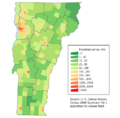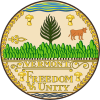Portal:Vermont
The Vermont Portal Vermont (/vərˈmɒnt/ ⓘ vər-MONT) is a landlocked state in the New England region of the Northeastern United States. It borders Massachusetts to the south, New Hampshire to the east, New York to the west, and the Canadian province of Quebec to the north. As of the 2020 U.S. census, the state had a population of 643,503, ranking it the second least populated U.S. state ahead of Wyoming. It is the nation's sixth smallest state in area. The state's capital of Montpelier is the least populous U.S. state capital. No other U.S. state has a most populous city with fewer residents than Burlington. Vermont is also well known for being the largest producer of true maple syrup in the United States for over 200 years. Native Americans have inhabited the area for about 12,000 years. The competitive tribes of the Algonquian-speaking Abenaki and Iroquoian-speaking Mohawk were active in the area at the time of European encounter. During the 17th century, French colonists claimed the territory as part of the Kingdom of France's colony of New France. After the Kingdom of Great Britain began to settle colonies to the south along the Atlantic coast, the two nations competed in North America in addition to Europe. After being defeated in 1763 in the Seven Years' War, France ceded its territory east of the Mississippi River to Great Britain. Thereafter, the nearby British Thirteen Colonies, especially the provinces of New Hampshire and New York, disputed the extent of the area called the New Hampshire Grants to the west of the Connecticut River, encompassing present-day Vermont. The provincial government of New York sold land grants to settlers in the region, which conflicted with earlier grants from the government of New Hampshire. The Green Mountain Boys militia protected the interests of the established New Hampshire land grant settlers against the newly arrived settlers with land titles granted by New York. Ultimately, a group of settlers with New Hampshire land grant titles established the Vermont Republic in 1777 as an independent state during the American Revolutionary War. The Vermont Republic abolished slavery before any other U.S. state. It was admitted to the Union in 1791 as the 14th state. (Full article...) Entries here consist of Good and Featured articles, which meet a core set of high editorial standards.
The Morgan horse is one of the earliest horse breeds developed in the United States. Tracing back to the foundation sire Figure, later named Justin Morgan after his best-known owner, as well as mares of the now-extinct Narragansett Pacer breed, Morgans served many roles in 19th-century American history, being used as coach horses and for harness racing, as general riding animals, and as cavalry horses during the American Civil War on both sides of the conflict. Morgans have influenced other major American breeds, including the American Quarter Horse, the American Saddlebred, the Tennessee Walking Horse, and the Standardbred. During the 19th and 20th centuries, they were exported to other countries, including England, where a Morgan stallion influenced the breeding of the Hackney horse. In 1907, the US Department of Agriculture established the US Morgan Horse Farm near Middlebury, Vermont for the purpose of perpetuating and improving the Morgan breed; the farm was later transferred to the University of Vermont. The first breed registry was established in 1909, and since then many organizations in the US, Europe and Oceania have developed. (Full article...)Selected article - The Vermont Republic (French: République du Vermont), officially known at the time as the State of Vermont (French: État du Vermont), was an independent state in New England that existed from January 15, 1777, to March 4, 1791. The state was founded in January 1777, when delegates from 28 towns met and declared independence from the jurisdictions and land claims of the British colonies of Quebec, New Hampshire, and New York. The republic remained in existence for the next fourteen years, albeit without diplomatic recognition from any foreign power. On March 4, 1791, it was admitted into the United States as the State of Vermont, with the constitution and laws of the independent state continuing in effect after admission. The delegates forbade adult slavery within their republic, although the Vermont constitution continued to make allowances for the enslavement of men under the age of 21 and women under the age of 18. Many Vermonters took part in the American Revolution on the side of the Revolution, but the Continental Congress did not recognize the independence of Vermont (then also known as the New Hampshire Grants) due to objections from New York, which had conflicting property claims. In a response to this, members representing Vermont conducted negotiations to join the Province of Quebec, which were accepted by the British, who offered generous terms for the republic's reunion. When the British surrendered at the Siege of Yorktown in 1781, however, American independence became apparent. Vermont, later bordered on three sides by U.S. territory, ended negotiations with Britain and instead negotiated terms to become part of the United States. (Full article...)General images -The following are images from various Vermont-related articles on Wikipedia.
Did you know -
TopicsCitiesVermont has nine incorporated cities.
CategoriesNew articlesThis list was generated from these rules. Questions and feedback are always welcome! The search is being run daily with the most recent ~14 days of results. Note: Some articles may not be relevant to this project.
Rules | Match log | Results page (for watching) | Last updated: 2024-04-27 22:06 (UTC) Note: The list display can now be customized by each user. See List display personalization for details.
Related portalsWikiProjectsAssociated WikimediaThe following Wikimedia Foundation sister projects provide more on this subject:
Sources |














































